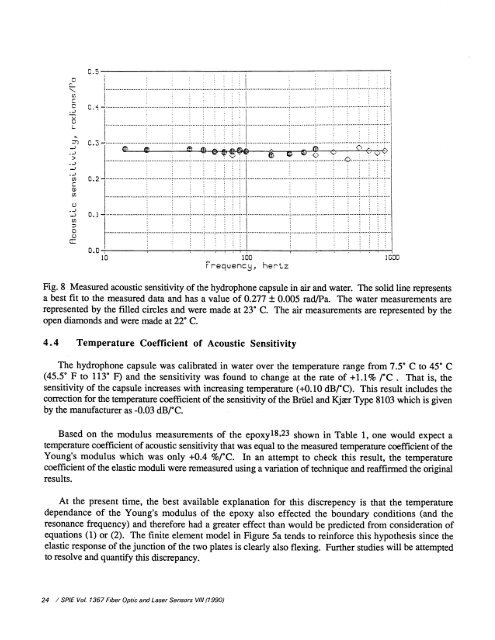A General Purpose Fiber-Optic Hydrophone Made of Castable Epoxy
A General Purpose Fiber-Optic Hydrophone Made of Castable Epoxy
A General Purpose Fiber-Optic Hydrophone Made of Castable Epoxy
You also want an ePaper? Increase the reach of your titles
YUMPU automatically turns print PDFs into web optimized ePapers that Google loves.
C. 5<br />
C-.<br />
Ct<br />
D.. —<br />
P<br />
><br />
C.3—<br />
am 4t am ,v,. - -<br />
cL 'p w'<br />
Cs)<br />
a)<br />
Li)<br />
0<br />
0.2<br />
U)<br />
C<br />
0<br />
100<br />
Freouenc, hertz<br />
DOD<br />
Fig. 8 Measured acoustic sensitivity <strong>of</strong> the hydrophone capsule in air and water. The solid line represents<br />
a best fit to the measured data and has a value <strong>of</strong> 0.277 0.005 rad/Pa. The water measurements are<br />
represented by the filled circles and were made at 23° C. The air measurements are represented by the<br />
open diamonds and were made at 22° C.<br />
4 . 4 Temperature Coefficient <strong>of</strong> Acoustic Sensitivity<br />
The hydrophone capsule was calibrated in water over the temperature range from 7.5° C to 45° C<br />
(45.5° F to 1 1 3° F) and the sensitivity was found to change at the rate <strong>of</strong> +1 .1% /°C . That is, the<br />
sensitivity <strong>of</strong> the capsule increases with increasing temperature (+0. 10 dB/°C). This result includes the<br />
correction for the temperature coefficient <strong>of</strong> the sensitivity <strong>of</strong> the Bruel and Kjer Type 8103 which is given<br />
by the manufacturer as -0.03 dB/°C.<br />
Based on the modulus measurements <strong>of</strong> the epoxy18'23 shown in Table 1, one would expect a<br />
temperature coefficient <strong>of</strong> acoustic sensitivity that was equal to the measured temperature coefficient <strong>of</strong> the<br />
Young's modulus which was only +0.4 %/°C. In an attempt to check this result, the temperature<br />
coefficient <strong>of</strong> the elastic moduli were remeasured using a variation <strong>of</strong> technique and reaffirmed the original<br />
results.<br />
At the present time, the best available explanation for this discrepency is that the temperature<br />
dependance <strong>of</strong> the Young's modulus <strong>of</strong> the epoxy also effected the boundary conditions (and the<br />
resonance frequency) and therefore had a greater effect than would be predicted from consideration <strong>of</strong><br />
equations (1) or (2). The finite element model in Figure 5a tends to reinforce this hypothesis since the<br />
elastic response <strong>of</strong> the junction <strong>of</strong> the two plates is clearly also flexing. Further studies will be attempted<br />
to resolve and quantify this discrepancy.<br />
24 / SPIE Vol. 1367 <strong>Fiber</strong> <strong>Optic</strong> and Laser Sensors V/li (1990)

















